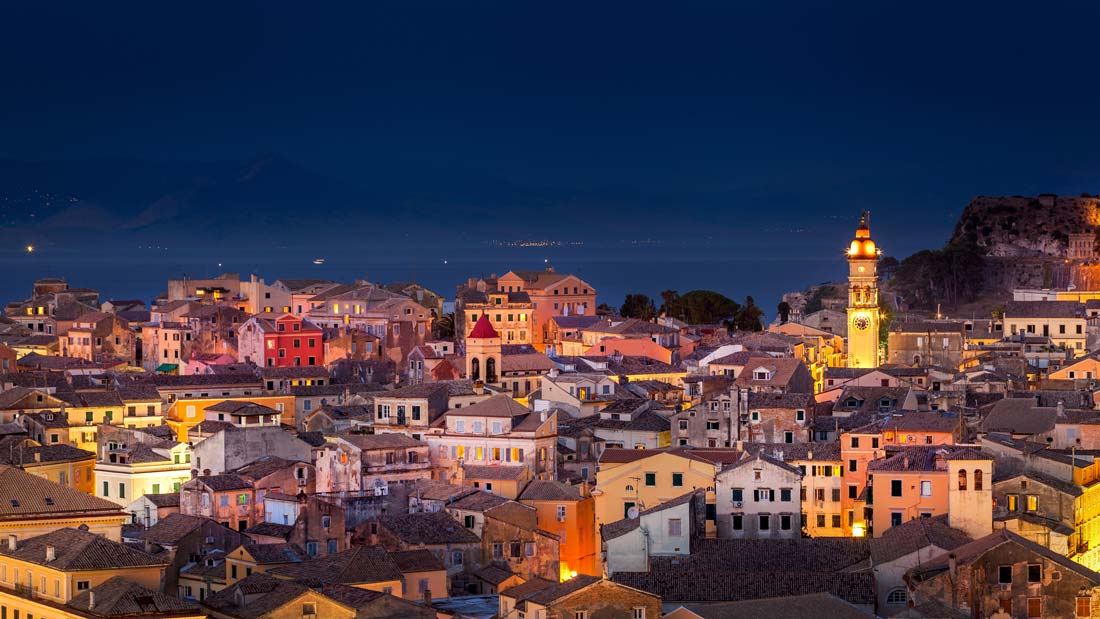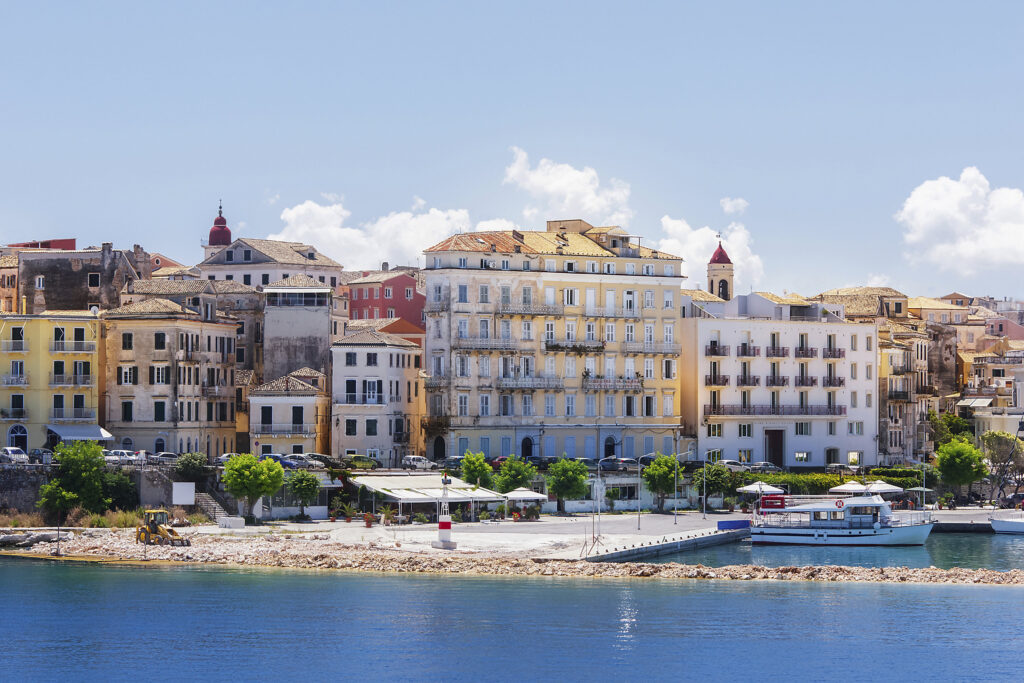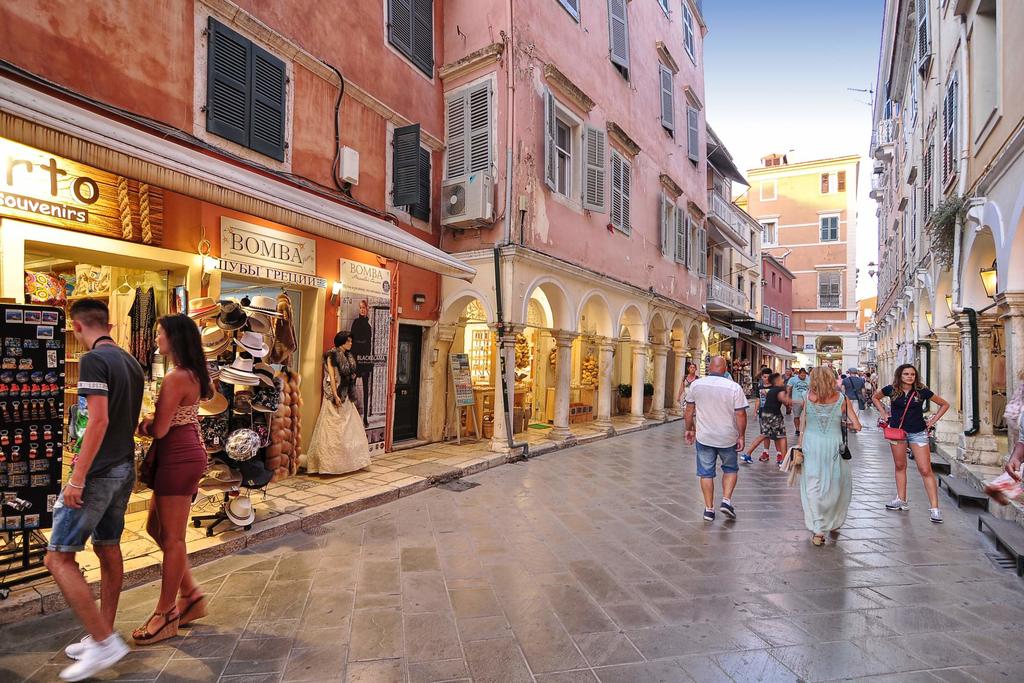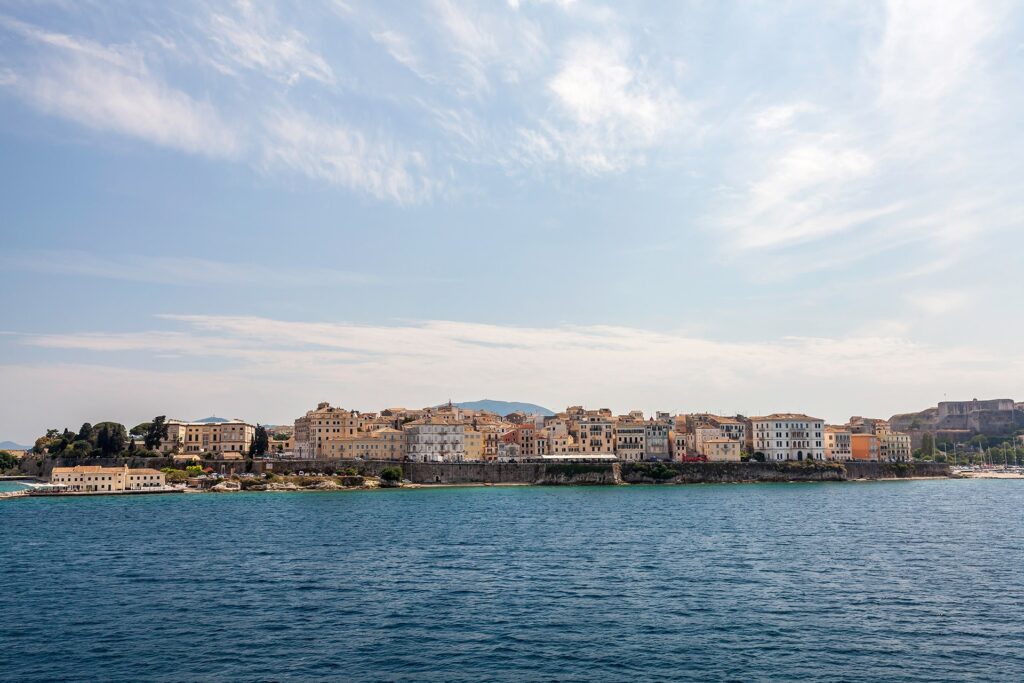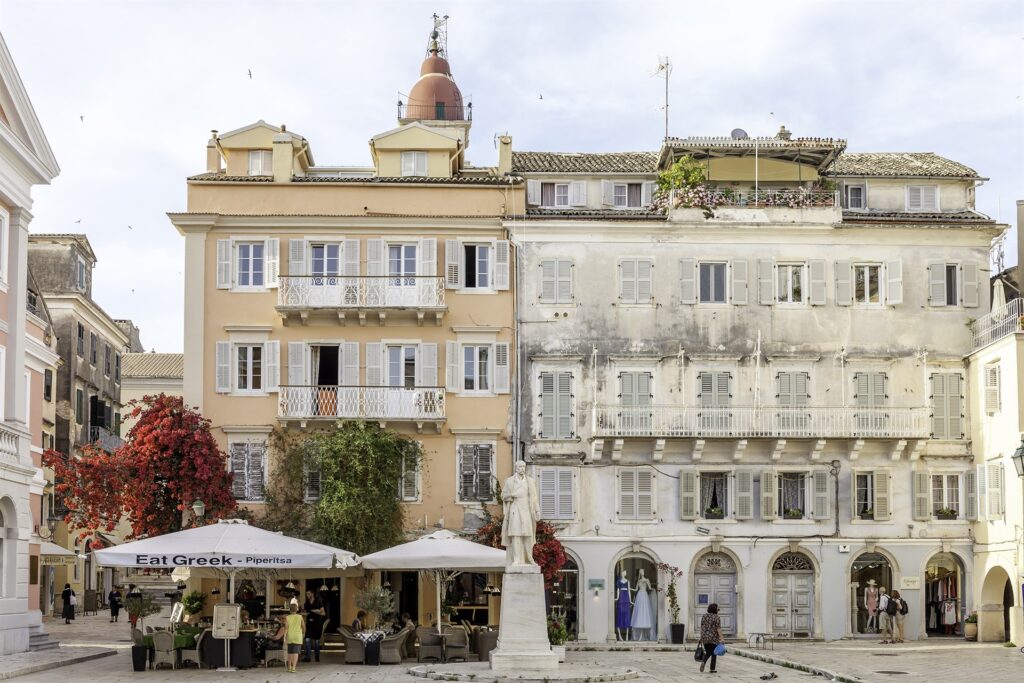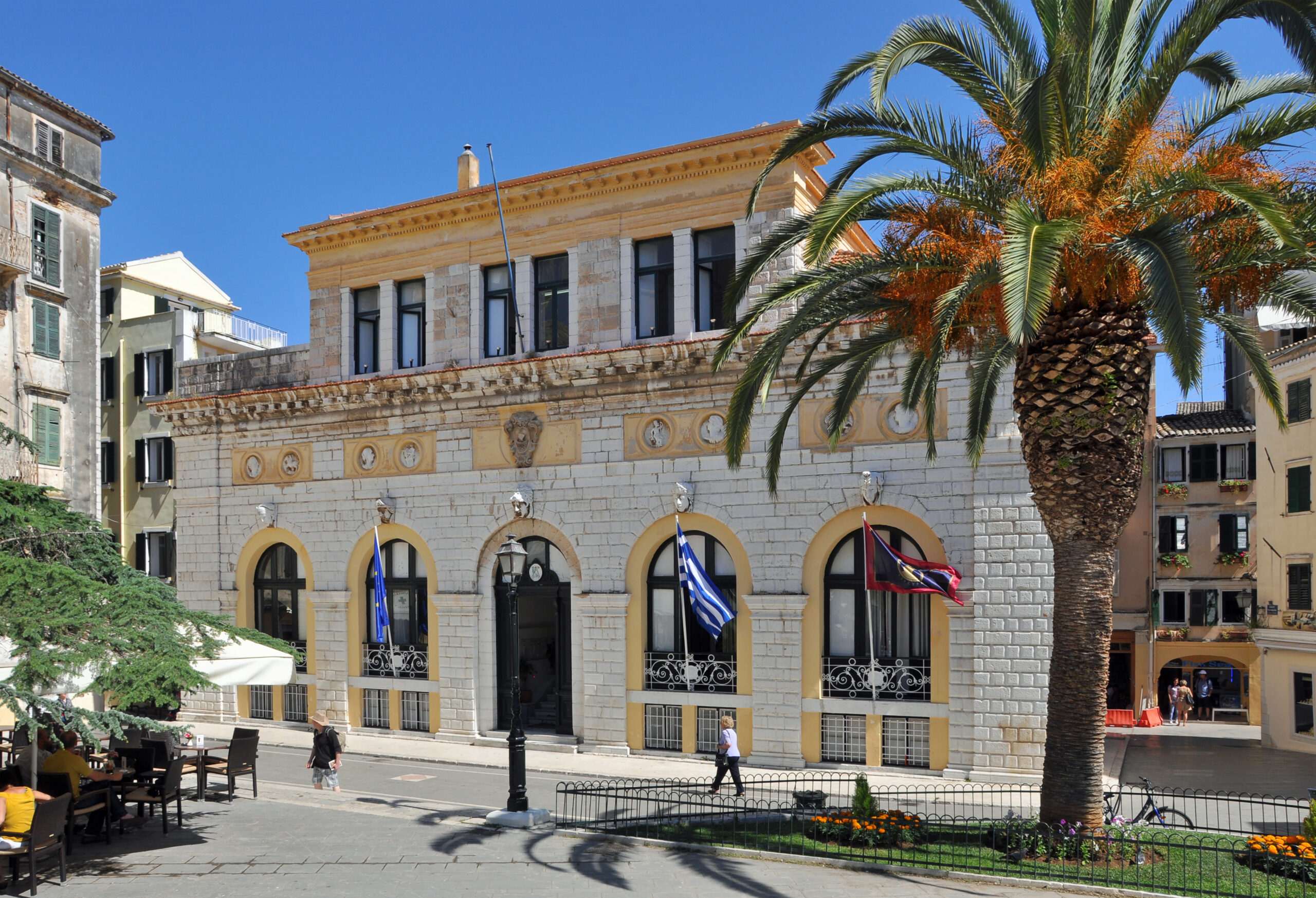Corfu or Kerkyra is a city and a former municipality on the island of Corfu, Ionian Islands, Greece. Since the 2011 local government reform, it is part of the municipality of Corfu island. It is the capital of the island and of the Corfu regional unit. The city also serves as a capital for the region of the Ionian Islands. The city (population in 2011: 39,674 residents and the whole island 111,975) is a major tourist attraction and Greek regional centre and has played an important role in Greek history since antiquity.
See
- Spianada (The Esplanade). Spianada is the central square and the meeting point of Corfu’s residents and visitors. It is built in the style of the Royal Gardens of Europe. At one time it was a firing range for Venetian troops.
- Liston. The Liston is a building complex with long arcades built in 1807 by the French imperial commissioner Mathieu de Lesseps, father of the constructor of the Suez Canal. It is an excellent example of architecture from Napoleonic period, when Corfu was part of the First French Empire. The design was inspired by the Rue de Rivoli in Paris. The Liston runs along the west side of the Spianáda.
- Old Fortress. A Byzantine fort rebuilt under Venetian rule. The fortress successfully repulsed Ottoman sieges in 1537, 1571 and 1716. The old Fortress houses the church of St. George, the Public library and the Hellenic Music Research Lab of the Ionian University. It was the location of a scene from the James Bond film For Your Eyes Only, in which the Mercedes of Emile Locque, the evil adversary, gets pushed off a cliff by Bond.
- New Fortress. Less impressive, the new fortress was built by the Venetians on the 16th century atop the San Marco Hill. The most significant attractions of the New Fortress are: the British barracks, the underground stoas, water ducts, ammunition storage rooms etc. The Museum of Ceramic Art is housed here. Theatrical performances, exhibitions and concerts are also held on the fortress premises.
- Archaeological Museum. The museum hosts collections of archaeological finds, including the impressive Gorgon pediment from the Temple of Artemis, dating from 585 BC. It is the oldest stone pediment in Greece and is described in the New York times review of the museum as the finest example of Archaic temple sculpture extant. Of particular note is the ‘Lion of Menecrates’, the work of a Corinthian sculptor of the Archaic period, dated to the end of the 7th century BC.
- Museum of Asiatic Art. More than ten thousand objects, from China, Japan, India, Tibet and Southeast Asia. The museum is housed in the former Royal Palace, an imposing three-storied building and a fine example of neoclassical architecture, located at the northern end of the Spianada.
- Byzantine Museum. A small church dedicated to Our Lady of Antivouniotissa, now housing a collection of Byzantine and post-Byzantine icons.
- Municipal Art Gallery (Royal Palace)
- Church of St Spyridon. The church of the patron saint of the island was built in 1589 and has a beautiful ceiling with the 17 gilded panels. The remains of St. Spyridon are held in a silver reliquary.
- Mon Repos Estate. A neoclassical-style villa which served as a summer residence for the British Lord High Commissioner of the United States of the Ionian Islands, Frederick Adam in the early 19th century. After the union with Greece in 1864, the villa was granted to the Greek Royal Family and renamed Mon Repos. Prince Philip, Duke of Edinburgh was born in Mon Repos on 10 June 1921. The mansion is now home to the Palaiopolis Museum.
- Pontikonisi. A beautiful islet that looks like a miniature and has become the city landmark.
- Achilleion. A palace built in Corfu by Empress of Austria Elisabeth of Bavaria, also known as Sissi after a suggestion by Austrian Consul Alexander von Watzberg. Sissi was a woman obsessed with beauty and very powerful but tragically vulnerable since the loss of her only son, Crown Prince Rudolf of Austria in the Mayerling affair in 1889. A year later in 1890 she built a summer palace in the region of Gastouri (Γαστούρι), now the municipality of Achilleion, about ten kilometres to the south of the city of Corfu. The palace was designed with the mythical hero Achilles as its central theme.
History
The ancient city of Corfu, known as Korkyra, took part in the Battle of Sybota which was a catalyst for the Peloponnesian War, and, according to Thucydides, the largest naval battle between Greek city states until that time. Thucydides also reports that Korkyra was one of the three great naval powers of fifth century BC Greece, along with Athens and Corinth.[3] Medieval castles punctuating strategic locations across the city are a legacy of struggles in the Middle Ages against invasions by pirates and the Ottomans. The city has become known since the Middle Ages as Kastropolis (Castle City) because of its two castles.
From 1386 to 1797, Corfu was ruled by Venetian nobility; much of the city reflects this era when the island belonged to the Republic of Venice, with multi-storied buildings on narrow lanes. The Old Town of Corfu has clear Venetian influence. The city was subjected to four notable sieges in 1537, 1571, 1573 and 1716, in which the strength of the city defenses asserted itself time after time, mainly because of the effectiveness of the powerful Venetian fortifications. Will Durant claimed that Corfu owed to the Republic of Venice the fact that it was the only part of Greece never conquered by the Ottomans.
In 2007, the old town of the city was inscribed on the UNESCO World Heritage List. The municipal unit of Corfu city has a land area of 41.905 km2 (16.180 sq mi) and a total population of 39,674 inhabitants. Besides the city of Corfu/Kérkyra, its largest other towns are Kanáli (population 4,086), Potamós (3,840), Kontokáli (1,660), Alepoú (3,149), and Gouviá (838).
